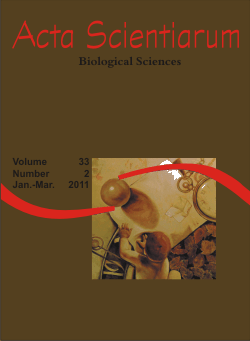<b>The impact of oxygen consumption by the shrimp <em>Litopenaeus vannamei</em> according to body weight, temperature, salinity and stocking density on pond aeration: a simulation</b> - doi: 10.4025/actascibiolsci.v33i2.7018
Resumo
A simulation was conducted to determinate the impact caused by the combination of Litopenaeus vannamei respiratory rate (mg O2 shrimp-1 h-1), the behavior of SOTR (kg O2 h-1) of mechanical aerators as a function of salinity, as well as the oxygen consumption rate of the pond water and soil (mg O2 L-1 h-1) on the aeration of shrimp ponds (1, 10, 50 and 100 ha) stocked with different densities (10, 40 and 120 shrimp m-2), salinities (1, 13, 25 and 37 ppt), temperatures (20, 25 and 30°C), and shrimp wet weight (5, 10, 15 and 20 g). Results showed that under lower salinity, with larger shrimp, and higher stocking density, higher will be the quantity of required 2-HP aerators to keep dissolved oxygen over 50% saturation. In addition, under low salinity, with 5 and 10 g shrimp, independent of stocking density, more aerators per hectare are required and electricity cost is higher at 20°C and salinity 1 ppt. Less aerators and lower electricity cost was observed at 30°C, salinities of 25 and 37 ppt, and shrimp of 15 and 20 g.Downloads
DECLARAÇÃO DE ORIGINALIDADE E DIREITOS AUTORAIS
Declaro que o presente artigo é original, não tendo sido submetido à publicação em qualquer outro periódico nacional ou internacional, quer seja em parte ou em sua totalidade.
Os direitos autorais pertencem exclusivamente aos autores. Os direitos de licenciamento utilizados pelo periódico é a licença Creative Commons Attribution 4.0 (CC BY 4.0): são permitidos o compartilhamento (cópia e distribuição do material em qualqer meio ou formato) e adaptação (remix, transformação e criação de material a partir do conteúdo assim licenciado para quaisquer fins, inclusive comerciais.
Recomenda-se a leitura desse link para maiores informações sobre o tema: fornecimento de créditos e referências de forma correta, entre outros detalhes cruciais para uso adequado do material licenciado.












1.png)




3.png)













